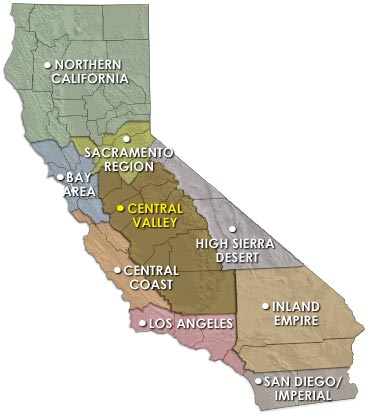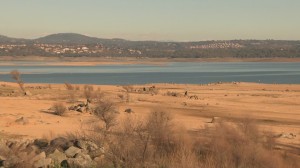California farmers to get ‘zero’ federal water
Daily News Article — Posted on February 27, 2014
(by Michael B. Marois, Bloomberg News) – Farmers in California’s Central Valley, the world’s most productive agricultural region, will get none of the water they requested this year from a federally controlled system because of the drought gripping the state, the U.S. Interior Department’s Bureau of Reclamation said.
 The bureau said in a statement it won’t be able to deliver any of the more than 2.4 million acre-feet of water sought by farmers. A state-controlled system last month said it, too, wouldn’t be able to deliver any of the 4 million acre-feet of water sought by local agencies. An acre-foot is the volume needed to cover an acre of land one foot deep with water. [The Fresno Bee reports: “The extreme dry winter has left the Sierra Nevada snowpack at 29% of average for late February. Major reservoirs in Northern California are less than half full. The U.S. Bureau of Reclamation, owner and operator of the CVP, has little water to offer.”]
The bureau said in a statement it won’t be able to deliver any of the more than 2.4 million acre-feet of water sought by farmers. A state-controlled system last month said it, too, wouldn’t be able to deliver any of the 4 million acre-feet of water sought by local agencies. An acre-foot is the volume needed to cover an acre of land one foot deep with water. [The Fresno Bee reports: “The extreme dry winter has left the Sierra Nevada snowpack at 29% of average for late February. Major reservoirs in Northern California are less than half full. The U.S. Bureau of Reclamation, owner and operator of the CVP, has little water to offer.”]
Governor Jerry Brown declared a state of emergency for the world’s 10th largest economy last month after 2013 turned into the driest year on record, leaving reservoirs at dangerously low levels. The dwindling availability of water means farmers will fallow hundreds of thousands of acres, boosting food prices across the U.S. and leaving farm workers jobless. The state has identified 10 rural towns with less than 100 days of supply remaining.
“In this county alone, we’re in the billions of dollars of lost economic activity,” said Ryan Jacobsen, chief executive of the Fresno County Farm Bureau. “We do compete on a global scale, but the reality is that there very likely is going to be a shortage of certain commodities.”
The Bureau of Reclamation supplies water to 1 million people and a third of the irrigated farmland in California through a 500-mile network of canals and tunnels. About two-thirds of California’s 38 million people get at least part of their water from northern mountain rains and snow through a network of state-managed reservoirs and aqueducts known as the State Water Project.

Federal officials said California farmers will not receive irrigation water this year from rivers, canals and reservoirs because of the state’s drought.
Some of the Bureau of Reclamation’s customers will receive about 40 percent of the water they ordered because they had pre-existing contracts with the agency.
[The Daily Telegraph reports: Farmers acknowledged the drought but also blamed California’s complicated water delivery system, and the environmental lobby, for exacerbating the drought. A chief target of their ire was the Delta smelt, a three-inch long fish the US Fish and Wildlife Service decided to protect several years ago. That prevented billions of gallons of water being channeled from the Delta’s smelt’s home in the Sacramento River to farms.Without its protection the Delta smelt would become extinct but farmers are of the view that people, and America’s economy, are more important. Daniel Errotabere, 58, a third generation farmer, who is fallowing 1,500 of his 5,200 acres this year, said: “It doesn’t make a whole lot of sense to us. When you waste a resource like that out to the ocean it’s hard to live with.”]
The drought in California, the top U.S. agricultural producer at $44.7 billion, is depriving the state of water needed to produce everything from milk, beef and wine to some of the nation’s largest fruit and vegetable crops, including avocados, strawberries and almonds.
The extreme dryness may boost annual food price inflation as California accounts for one-third of U.S. vegetable output, and two-thirds of fruit and nut production, Joe Glauber, the U.S. Department of Agriculture’s chief economist said at an agency outlook forum yesterday.
Retail tomato prices jumped 10 percent in the 12 months through Jan. 31, and U.S. retail prices for beef, bacon, lettuce and broccoli posted double-digit gains last year, even as total food inflation advanced just 1.4 percent, government data show.
“It’s kind of a disappointing epitaph to the drought,” said Mike Wade, executive director of the California Farm Water Coalition. “It just confirms how short water supplies are this year. In the coming months this confirms that there isn’t going to be enough water to plant cantaloupes, watermelons, things like that.”
The drought is another blow to dairies, the state’s largest agricultural business with 2012 revenue of $6.9 billion, producing 20 percent of U.S. milk output. Milk prices are up 20 percent in 2014, the fifth-biggest gain among 64 commodities tracked by Bloomberg. Class III milk futures, tracking a variety used to make cheese, reached $23.43 per 100 pounds on Jan. 31, the highest for the most-active contract since trading began in January 1996.
Originally published Feb. 21. Reprinted here for educational purposes only. May not be reproduced on other websites without permission from Bloomberg News (bloomberg .com).
Background
California’s Central Valley is one of the world's most productive agricultural regions. Last week, the Department of Interior's Bureau of Reclamation, which supplies water to a third of the irrigated farmland in California through a 500-mile network of canals and tunnel, said it won’t be able to deliver any of the water sought by farmers.
There is hope - KCRA TV News reports:
By late Wednesday [Feb. 26] the National Weather Service expects a storm to sweep through the region, bringing significant showers. The weather is expected to break Thursday, with rain continuing Friday and Saturday. "The state needs a succession of storms dumping mountain snow," said Pete Lucero of the Bureau of Reclamation. "Rain is nice, but snow is where the money is," he said.
The U.S. Department of the Interior:
The United States Department of the Interior (DOI) is the federal executive department of the U.S. government responsible for the management and conservation of most federal land and natural resources, and the administration of programs relating to American Indians, Alaska Natives, Native Hawaiians, territorial affairs, and insular areas of the United States. The Department is administered by the United States Secretary of the Interior, who is a member of the Cabinet of the President. (wikipedia)
The Bureau of Reclamation
- The Bureau of Reclamation is a federal agency under the U.S. Department of the Interior, which oversees water resource management, specifically as it applies to the oversight and operation of the diversion, delivery, and storage projects that it has built throughout the western United States for irrigation, water supply, and attendant hydroelectric power generation.
- Established in 1902, the Bureau of Reclamation is best known for the dams, powerplants, and canals it constructed in the 17 western states. These water projects led to homesteading and promoted the economic development of the West. Reclamation has constructed more than 600 dams and reservoirs including Hoover Dam on the Colorado River and Grand Coulee on the Columbia River.
- Today, we are the largest wholesaler of water in the country. We bring water to more than 31 million people, and provide one out of five Western farmers (140,000) with irrigation water for 10 million acres of farmland that produce 60% of the nation's vegetables and 25% of its fruits and nuts. (from wikipedia and usbr.gov)
The Central Valley Project
- The Central Valley Project (CVP) is a federal water management project in California under the supervision of the Bureau of Reclamation.
- It was devised in 1933 in order to provide irrigation and municipal water to much of California's Central Valley—by regulating and storing water in reservoirs in the water-rich northern half of the state, and transporting it to the water-poor San Joaquin Valley and its surroundings by means of a series of canals, aqueducts and pump plants, some shared with the California State Water Project (SWP). (from wikipedia and water.ca.gov/swp/cvp.cfm)
The California State Water Project:
- The California State Water Project is a state water management project in California under the supervision of the California Department of Water Resources.
- The SWP is the world's largest publicly built and operated water and power development and conveyance system – providing drinking water for more than 23 million people and generating an average of 6500 GWh of hydroelectricity annually.
- The SWP collects water from rivers in Northern California and redistributes it to the water-scarce but populous south through a network of aqueducts, pumping stations and power plants.
- About 70% of the water provided by the project is used for urban areas and industry in Southern California and the San Francisco Bay Area, and 30% is used for irrigation in the Central Valley.
- To reach Southern California, the water must be pumped 2,000 feet over the Tehachapi Mountains – the highest single water lift in the world.
- The SWP shares many facilities with the federal Central Valley Project (CVP), which primarily serves agricultural users. Water can be interchanged between SWP and CVP canals as needed to meet peak requirements for project constituents.
- Since its inception in 1960, the SWP has required the construction of 21 dams and more than 700 miles of canals, pipelines and tunnels. (from wikipedia and water.ca.gov/swp)
